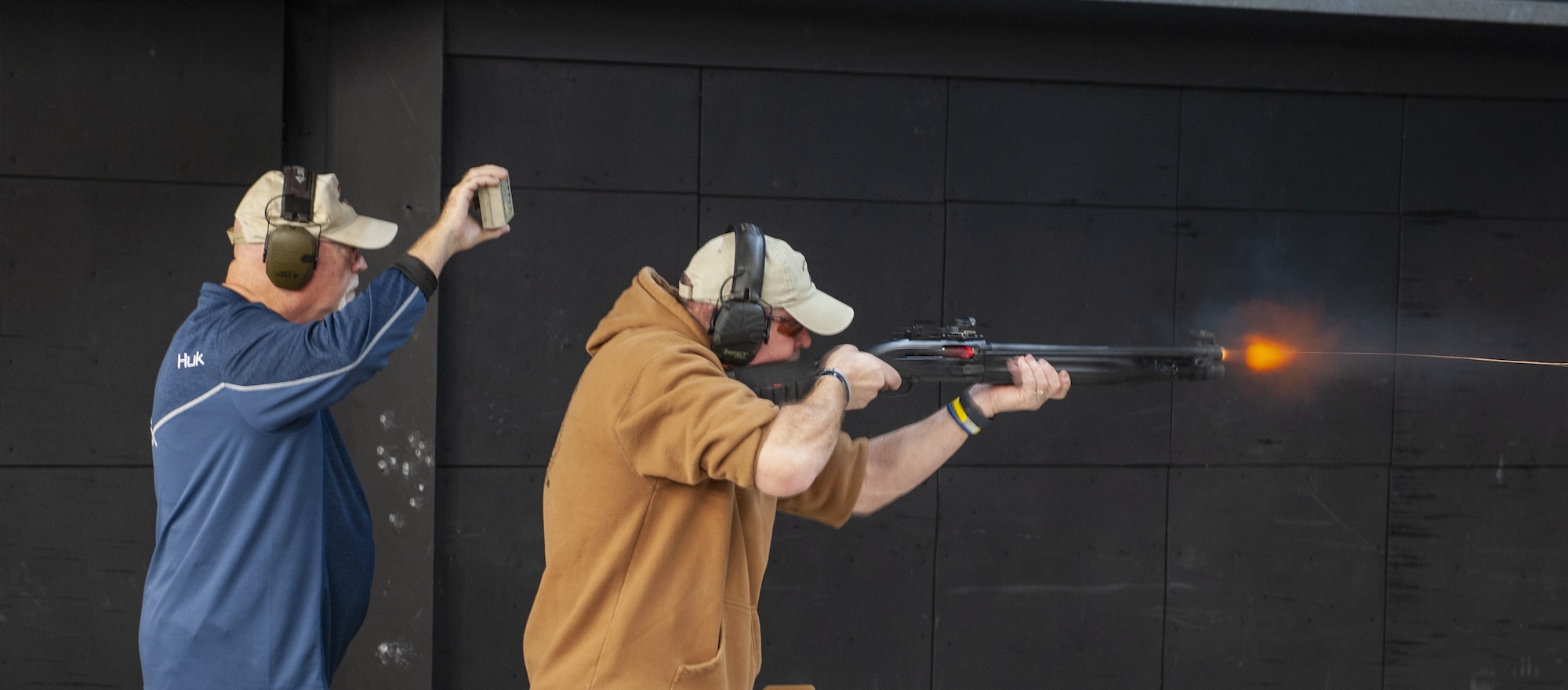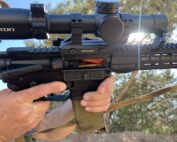
RSGIclass2023_113pro
We had just finished a call involving pointing guns at dangerous suspects that ended well, all in custody with nobody hurt. One of my partners walked up to me, holding a wood and steel shotgun at arm’s length, and asked me to unload it. Even before the age of patrol rifles, familiarity with this mightily effective tool was not every patrol officer’s strength. Negligent discharges were not uncommon with shotguns as well. How do we fix this?

The 40,000-square-foot facility at Royal Range, a converted movie theater, was a great host for the class.
I’ve always been a “shotgun guy” and had previously attended Tom Given’s Rangemaster one-day defensive shotgun course. When the opportunity to attend his three-day instructor-level class at Royal Range near Nashville, Tennessee, aligned with my schedule, I wanted to see if there was an effective way to answer this question.
The Students
The 22 students were mostly home defense and law enforcement trainers. Givens observed, “When I was growing up, nearly everyone was a hunter,” noting how the percentage of the population with hunting licenses has significantly diminished. Commonly, people grew up familiar with shotguns, but no longer. Many attend his classes to obtain formal training to build a solid foundation. He frequently provides historical perspectives to help students better understand the “why” of where we are now.

Participants were either shooting, loading, or waiting their turn during a “Rolling Thunder” drill during class. Not wanting to let your partners down creates good stress.
In the era of ubiquitous patrol rifles replacing shotguns, Givens opines that each is a unique tool serving different purposes. “With enlightened agencies, you see both,” Givens shared. Shotguns have advantages, including limiting downrange hazards (rifle rounds travel much further than even buckshot), lower chance of overpenetration, and frequent, one-shot stops of deadly force threats. However, they do not have the precision of a rifle with an optic when that is the needed tool.

One student reviews his pattern from 00 buckshot testing. It is important to know how your gun patterns the shells you use.
Myth Busting
The course mixed plenty of manipulations and shooting with discussions about what students new to the shotgun should know. This included dispelling myths such as extremely wide pattern spread at close distances and (because of this untruth) that there is no need to “aim” a shotgun, just point and shoot.

Student targets during buckshot patterning activity. The higher shot in the head area was a single 00 buck round at close range, with the center mass shots (multiple taken) further back. Notice the variation in patterns from different brands.
Each student patterned their shotgun at different distances to learn how their buckshot spread. Being able to look at other students’ shot spread was enlightening. Some modern offerings, such as Federal 00 buck with Flight Control wads, displayed exceptionally tight patterns even at a distance. Others, without the benefit of hardened shot or buffer material, spread more quickly and had a higher frequency of a pellet turning into a “flyer,” well outside the main pattern. Givens points out that shotgun barrel/buckshot combinations are like “snowflakes,” no two are the same, and you must know what works with your gun.
Manipulations
Givens notes that shotguns, even semiautomatic variants, operate very differently from handguns and rifles. It is typically easier to instruct students on operating a patrol rifle once they learn how to operate their handgun. Because of the differences, repetitive manipulations help to build good habits for tasks including loading, operating pump action shotguns, safety use, and other functions. Repeated practice in class helped us to better relate to how our students learn best with these tasks.

Reloading during the class emphasized using shell holders on the gun. This is typically where immediately accessible shotgun ammunition is carried, so you should practice keeping the gun fed from buttstock and sidesaddle devices.
Mixing the manipulations with live fire exercises such as “shoot one, load one” drills helps with the foundation. Givens emphasizes practicing loading from shell holders that you would have with you in a fight, generally meaning your ammunition needs to be on the gun. During the class, we did nearly all of our loading from buttstock sleeves and receiver-mounted shell carriers. If you don’t carry extra shells on your vest or belt in patrol, it is not useful to practice loading from these locations. Most of the drills were conducted with more cost-effective bird shot with ample practice with buckshot and some slug work at longer distances.
Drills
Givens gave us two drills that any shotgunner can practice. The first is the Rolling Thunder drill. This drill combines shooting, loading (both single loading and the magazine tube), and time pressure. Beginning with an empty gun, at the start, you load one round and shoot, then load two (the first shell in the chamber to keep your weapon in the fight) and shoot two, then load three, shoot three, and finish with loading four and firing all four. At your range, you should use a timer (focus on perfect loading and accurate shooting). In class, we had two teams of four shooters competing against each other with the twist that you cannot shoot your shot(s) until the person next to you is done. If you mess up a reload, the peer pressure is on.

Givens timing a student during individual drills. Several of the drills were conducted for individual times, allowing shooters to get an idea of what to expect from their own students.
The second drill is the shotgun version of Givens’ own Casino Drill. In class, we used four numbered steel plates (not placed in order). You start by loading five shells, firing one shot at plate #1, then two shots at plate #2; by the time you get to plate #3, you will need to reload to make all three shots, finishing with four shots on the final plate. This drill emphasizes loading, multiple shots, target transitions (remember to lead with your eyes first), and thinking about reloads (you can load in different ways after the initial five shells). Cardboard and paper can be substituted for steel.

Givens walks behind students during a close contact threat exercise. We often do not get to pick the distance of our encounters so we must be prepared for shooting at close range, something often forgotten with shotgun practice.
Final Thoughts
A tool that is not understood will seldom be used or will be used improperly. Sadly, law enforcement shotguns can fall into this category. Givens points out that shotguns and ammunition are the best they have ever been for use in the field. It’s up to trainers and officers to maximize their value — and not rely on others to unload them in the field.
RESOURCE:














